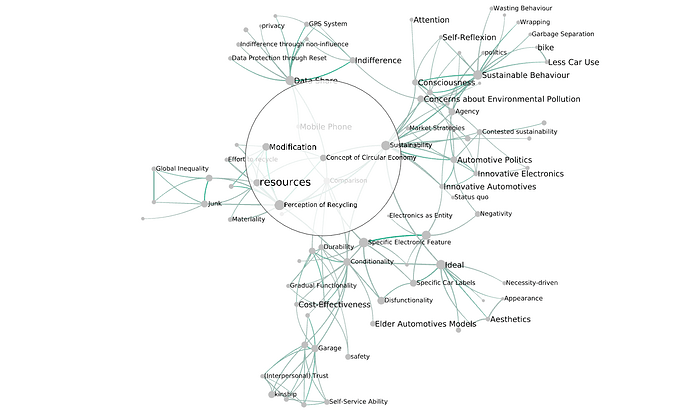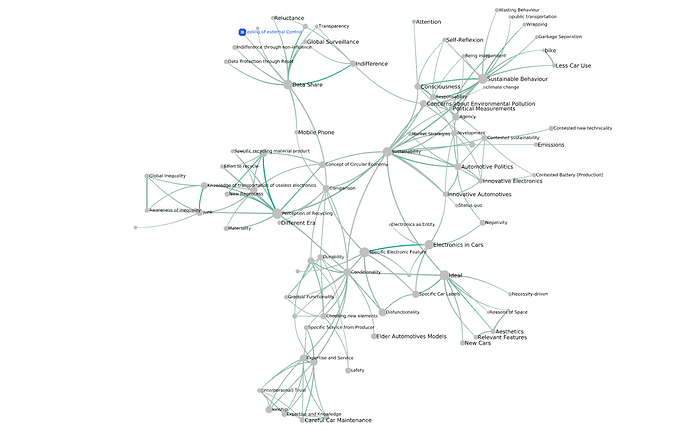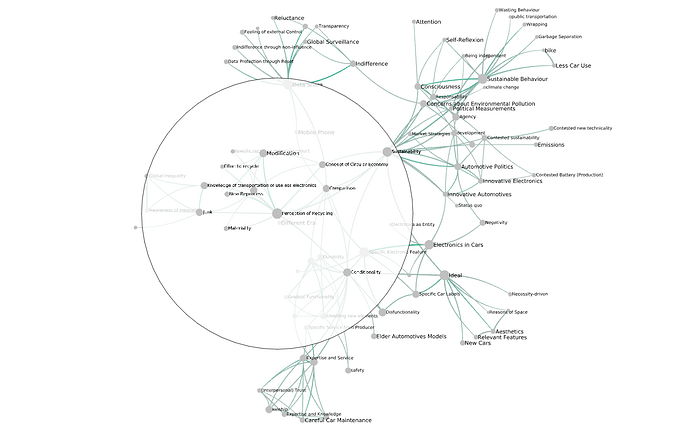A look at some key codes.
I am going to use only association depth to a first approximation. In this corpus, association depth and breadth are exceptionally well correlated. Their (Pearson) correlation coefficient is 0.96, statistically significant with, to all practicall purposes, certainty.
Concept of circular economy. At b >= 7, it connects to the hub that is Sustainability, and to Modification, Perception of recycling and Resources.
To get a bit more granularity, I visualized the graph for b >= 4 (126 codes, 442 edges). Here more “political” codes appear.
list of neighbors of `Concept of circular economy` at b >= 4
Automotive Politics
Buzzword
Comparison
Concept of Circular Economy
Contested Battery (Production)
Contested new technicality
Contested sustainability
Different Era
Durability
Effort to recycle
Innovative Automotives
Materiality
Modification
New Reprocess
Perception of Recycling
Replacement
resources
Resources needed to recycle
Sustainability
Sustainable behaviour. This code is already a hub at b >= 7. It is a senter of a cluster that connects to the rest of the graph via sustainability, indifference and Electronic in cars.
list of neighbours of `Sustinable behaviour` at b >= 7
Agency
Being independent
bike
Concerns about Environmental Pollution
Consciousness
development
Garbage Separation
Less Car Use
Political Measurements
public transportation
Responsability
Self-Reflexion
Sustainability
Sustainable Behaviour
Wasting Behaviour
Wrapping
agency. At b>= 7, this code in in the same general cluster as sustainable behaviour and sustainablity, and direcly connected to both. Other direct neighbours at this (high) level of b are Being independent, consciousness and responsibility.
If I lower my threshold for b to 5 or 4 only one more code appears as a direct neighbor, self-reflection. Going down to b >= 3 (154 codes, 721 edges), I get a few more, but they don’t seem very illuminating:
direct neighbours of `agency` at b >= 3
Agency
Being independent
Comparison
Consciousness
development
Environmental Pollution
Market Strategies
Responsability
Self-Reflexion
Self-Service Ability
Sustainability
Sustainable Behaviour
Wasting Behaviour
Feeling of external control. At b >= 7, this code is present but only connected to Data share. This is also true if I lower the threshold to 5. At b >= 4 a second edge appears, to conditionality. At b >= 3 there are two more: to Global Surveillance and Critical about information/Knowledge dissemination.
Perception of recycling. This is another hub, even at b >= 7. It connects to the rest of the graph via Sustainability, Concept of circular economy, and Conditionality.
Its direct neighbours are:
direct neighbours of `Perception of recycling` at b >= 7
Comparison
Concept of Circular Economy
Conditionality
Effort to recycle
Junk
Knowledge of transportation of useless electronics
Materiality
Modification
New Reprocess
Perception of Recycling
resources
Specific recycling material product
Sustainability
Lowering my threshold to 5 only adds a few codes: Automotive politics, Replacement, Resources needed to recycle.
Modularity
I also ran some modularity analysis. The stacked graph is not very modular, but not quite random either (Q = 0.37, using b as a measure of edge strength. The results do not change significantly using d). The reduced graph for b >= 7, however, is much more modular, and you can even see the modularity just by looking at it: Q = 0.72. Below, I have colored nodes by the community they belong to (in network slang, by their class in the maximal modularity partition). The result is visualized below:
Here’s a list of the codes in each of the six communities. They are listed in alphabetical order: the star * indicates the highest-connected code in that community.
codes in the "pros and cons of electronics in cars" (grey) community
Aesthetics
Appearance
Disfunctionality
Electronics as Comfort
Electronics as Entity
Electronics as regulatory Mechanism
Electronics in Cars
Ideal *
Necessity-driven
New Cars
Reasons of Space
Relevant Features
Specific Car Labels
Specific Electronic Feature
codes in the "materiality and circular economy" (red) community
Awareness of Inequality
Concept of Circular Economy
Effort to recycle
Global Inequality
Junk
Knowledge of transportation of useless electronics
Lack of Knowledge about recycling processes
Materiality
Modification
New Reprocess
Perception of Recycling *
resources
Specific recycling material product
codes in the "personal expertise networks" (yellow) community
(Interpersonal) Trust
Careful Car Maintenance
Expertise and Knowledge
Expertise and Service
Garage *
kinship
Self-Service Ability
Specific Service from Producer
codes in the "deliberation/consideration by drivers" (green) community
Choosing new elements
Choosing used elements
Conditionality *
Cost-Effectiveness
Durability
Elder Automotives Models
Gradual Functionality
Guarantee of Quality
safety
codes in the "data sharing and surveillance" (purple) community
Comparison
Data Protection through Reset
Data Share *
Different Era
Feeling of external Control
Global Surveillance
GPS System
Indifference
Indifference through non-influence
Mobile Phone
privacy
Reluctance
Transparency
codes in the "systemic consideration of sustainability" (blue) community
Agency
Attention
Automotive Politics
Being independent
bike
climate change
Concerns about Environmental Pollution
Consciousness
Contested Battery (Production)
Contested new technicality
Contested sustainability
development
Emissions
Environmental Pollution
Garbage Separation
Innovative Automotives
Innovative Electronics
Less Car Use
Market Strategies
Negativity
Political Measurements
politics
public transportation
Responsability
Self-Reflexion
Status quo
Sustainability *
Sustainable Behaviour
Wasting Behaviour
Wrapping






